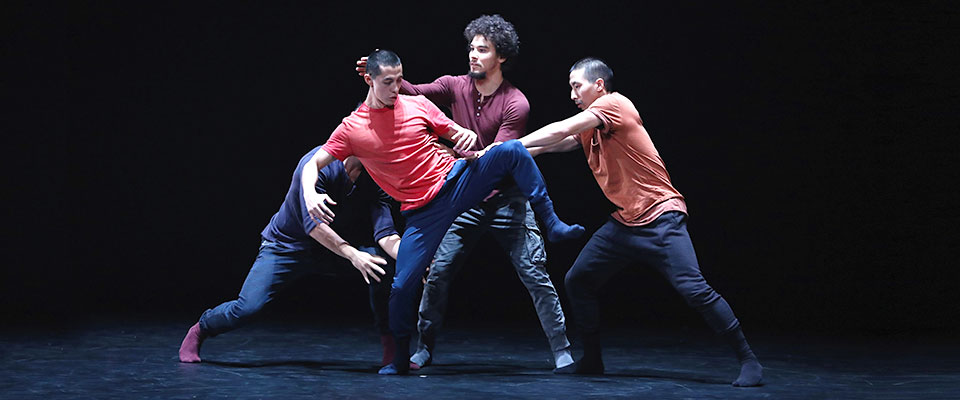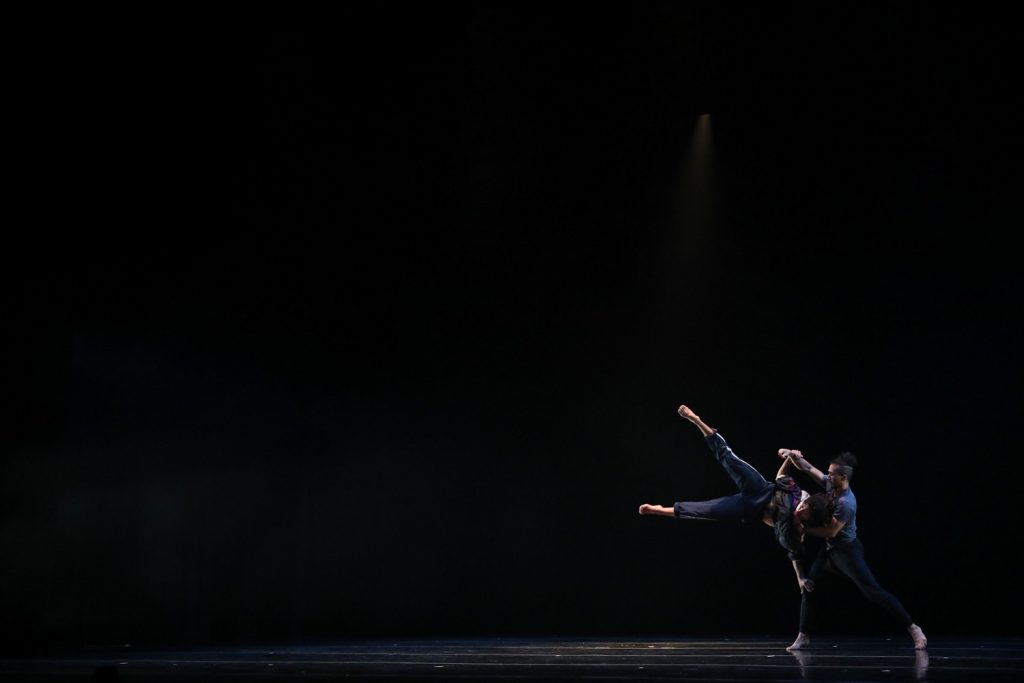Featured image photo by Mary Mallaney. Logo courtesy of RUBBERBAND dance company.
Victor Quijada is no stranger to Iowa City. He first came to the city in 1996 when on tour with Twyla Tharp’s dance company THARP!. That performance was eight years before he founded his dance company RUBBERBAND. However, due to the infamous flood of 2008 that shut Hancher down, RUBBERBAND traded a performance for sandbagging.
“It’s been a long time coming for our chance at Hancher,” Quijada said on Feb. 13 at the Creative Matters lecture located in Hancher’s Strauss Hall.
Chuck Swanson, the moderator of the conversation and Hancher Executive Director, said he knew after the 2008 cancellation that he would bring Quijada and his company back to Iowa City.
With Quijada’s return to Iowa City, his company performed “Vic’s Mix,” a 90-minute piece. Quijada described the performance as the company’s greatest hits. The two-act piece, a conglomeration of different works, was created to celebrate the company’s 15th anniversary in 2017.
“Vic’s Mix” was a showcase of explosive athleticism, remarkable artistry, and connectivity among dancers.
The work started with portions of his greatest hits from early in his career. This was when he was experimenting on how to create a movement vocabulary from his involvement in different forms of dance: hip hop, ballet and contemporary dance. Quijada prepares his dancers for this type of choreography with a method he developed called the RUBBERBAND Method.
As the curtain rose, three male dancers stood in a fog of theatrical haze. The haze was thick enough that there didn’t seem to be a back of the stage. Three dim yellow spotlights shone down on them. Their individualized pedestrian costumes of black pants of joggers or jeans, black shirts and black tennis shoes were hardly distinguishable from the background of the stage.
Act one began with a call to hip hop dance. The dancers moved with power exemplified by punches thrown at the air. This movement was juxtaposed against music from the ballet “Romeo and Juliet.” A reminder to Quijada days as a high schooler at Los Angeles County High School for the Arts.
In the years leading up to arts high school, Quijada had already become a dancer.
“I had gotten swept up in this brand-new hip-hop culture,” he said.
While in high school, though, he received some of his first encounters with what he called “art with a capital A” or “high art.” Here he learned about creators — in his recollection, Igor Stravinsky, John Cage, Arnold Schoenberg, Pablo Picasso, among others — that changed the way people see their respective mediums. The idea of changing the way people view a medium is something he said he would like to leave as part of his legacy.
Hip hop is often viewed as a much different art form than ballet and contemporary dance. It wasn’t until recent years with shows like So You Think You Can Dance, that contemporary dance and hip hop had crossed over in the mainstream. However, Quijada has been working for years fusing these genres in the concert dance arena to change the way people look at hip hop. He does this by not just placing a hip hop move next to a ballet position, but by integrating them and applying different movement qualities then are typically associated with the movement styles.
While Quijada had been a dancer for most of his life, that is not the case for all his dancers. For his dancers, specifically the four men and three women he brought along for this performance, their backgrounds are quite varied. Some started ballet and contemporary as small children, while others migrated from hip hop, gymnastics, visual arts and even circus performance.
“I found it super interesting that everyone came from such different backgrounds to create a cohesive show,” said Jensen Steinbronn, a third-year dance major.
The chemistry was seen as they interlaced their limbs and bore each other’s weight, their eyes would meet and linger before cascading into the next movement.
Together the dancers performed insane athletic feats while partnering and keeping a fluidity from one movement to the next. From front walkover overs completed over the top of a partner to carrying another dancer on one’s shoulder.
The first act was explosive with breakdance skills and fast punching movements. The dancers hardly had a moment to catch their breath between inverting their bodies and intricate floor work. Quijada introduced both the emotionality and comedy that he often features in his works.
The dancers had intimate chemistry that let the audience into the relationships as they partnered and worked in unison. The chemistry was seen as they interlaced their limbs and bore each other’s weight, their eyes would meet and linger before cascading into the next movement. Their touch on each other was gentle but not without intent.
Yet, within those partnerings, there were moments a dancer would pause in an unusual position that garnered laughs from the crowd. For instance, a dancer hung horizontally from their partner with their legs split in an “L” shape as the partner dropped them only a few inches from the floor.
As the first act came to a close, two dancers reached for each other’s hands. Their hands clasped together, and they hinged backward. They supported each other in a counterbalance — they looked as though they were sitting with no chairs. All the lights had gone down beside the white, hazy spotlight on the two dancers. Their bodies undulated as their torsos moved to run parallel to the floor. Their arms reached toward the sky and lowered toward their ears, to finish the shape.
That shape was a stunning finale to the first act, a beautiful rather serious, emotional exploration of how hip hop, ballet and contemporary dance could intertwine.

Act two featured pieces of his works after he established his method and movement vocabulary.
From the moment the curtain came up, it was clear there was a change. Instead of dark costumes, there were brighter costumes paired with vivid socks of red, yellow, tan and blue among other colors. The transition from tennis shoes to socks indicated an alteration in movement style—athletic shoes are commonly used for hip hop while socks are common in contemporary dance. Thus, act two had more melding of genres.
An important feature of this portion was the enhancement of the comedy and breaking of the fourth wall. In one portion, the wrong piece of music was played for a solo. While the playing of the wrong music was staged, it set the dancers off on a hilarious journey. The three dancers tried to instruct the music technician to the right music piece. They ended up fighting amongst themselves on the best route to handle the problem. This moment transitioned to an arresting marriage of the three music pieces.
Not to mention the comedic moment earlier in the piece when a trio of dancers couldn’t stop bowing after their section of choreography. As the lights flashed on and off, they reappeared and bowed again and again and again. Each time they were wearing a different face of weariness, embarrassment or joy. Until one dancer remained, and they carried him off stage.
These dancers proved they are at least double threats as both dancers and actors of comedy and deeper emotions.
From here, six of the dancers dove into duets. They used impressive flips and lifts while using balletic positions and moments of longing often seen in contemporary dance.
This sequence left a searing image. Two dancers dressed in blue gently embraced under a spotlight. She gingerly backed offstage in silence, away from the embrace as he was left on stage. He reached for her as the spotlight went down.
This quiet moment, in movement and sound, seemed to have an astounding difference to the uproarious moments of comedy earlier in act two. Although, the inclusion of both felt right. The comedy and the hushedness of this moment relayed the complex feelings of human beings.
It wasn’t only the dancing that swept the audience away.
“The lighting was stunning,” Steinbronn said.
Blue and yellow lights were used to match the emotion along with flashes of light and darkness.

The music was another spectacular element. While the music was carefully planned and utilized, the moments of silence were just as effective. In the moments of silence, the audience held their breaths. The silence was so loud it was ringing in the room. Often silence in dance can seem like a novelty, but each silence was used with specific intent to heighten the tension in the room.
After the show finished and the dancers took their bows to a standing ovation from the whole room.
“It was easy for non-dancers to watch,” Steinbronn said.
The movement was indeed complicated, but the sentiment of the work was presently so clearly that anyone could appreciate it. That appreciation was clear from the audible gasps from the expanse of the audience. As well as from the woman in the left parterre who every few moments clenched her chest with her hand as the dancers bounded across the stage.
After the bows, it was clear how they were able to form such tight bonds in the moment. They began a cypher, where typically hip-hop dancers gather in a circle and take turns improvising in the center. The audience truly got to see the style and background of each dancer — including massive tumbling skills and even Quijada showcasing his breaking skills.
Each took turns in the center improvising movements and cheered on their colleagues. It was like watching a family dance together.
The evening was a recollection of the best of Quijada’s works, exploring his early years as he discovered the RUBBERBAND Method and later in his career as he approached a wider variety of topics. Yet, Quijada notes that there were a lot of less successful pieces in between the greatest hits.
The week or so, RUBBERBAND was in Iowa City brought an influx of creativity and insight. For any creator or aspiring creator, leave with this:
“I think creativity is kind of like lift,” Quijada said, “It will find a way. It is just waiting to flourish.”
RUBBERBAND will be returning to Iowa City this May for an intensive for the students of the UI Dance Department. This is in preparation for a restaging of a piece to be performed with the company and students at ‘Big Splash,’ a celebration of 100 years of the UI IIHR – Hydroscience & Engineering.

